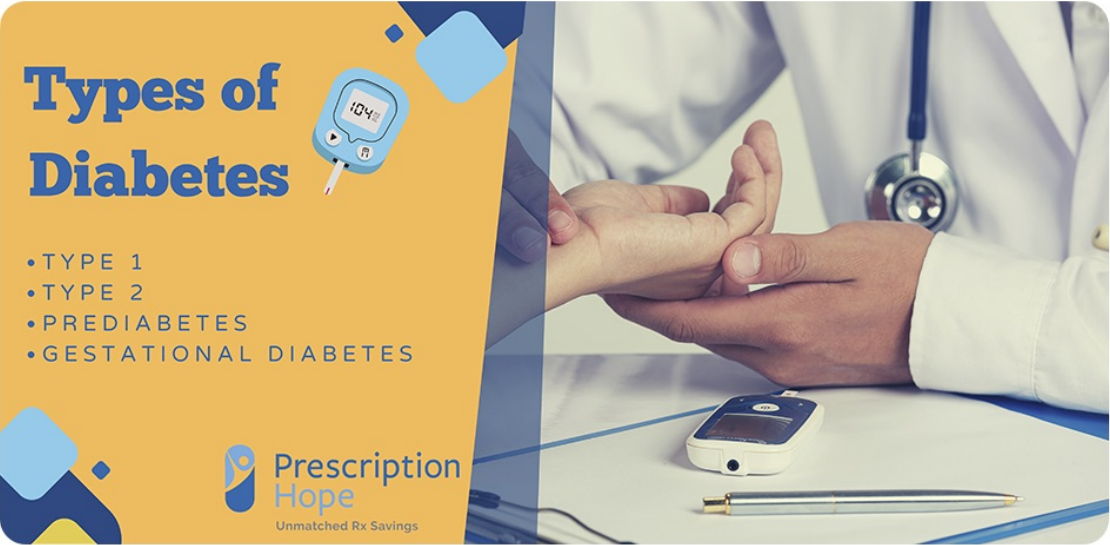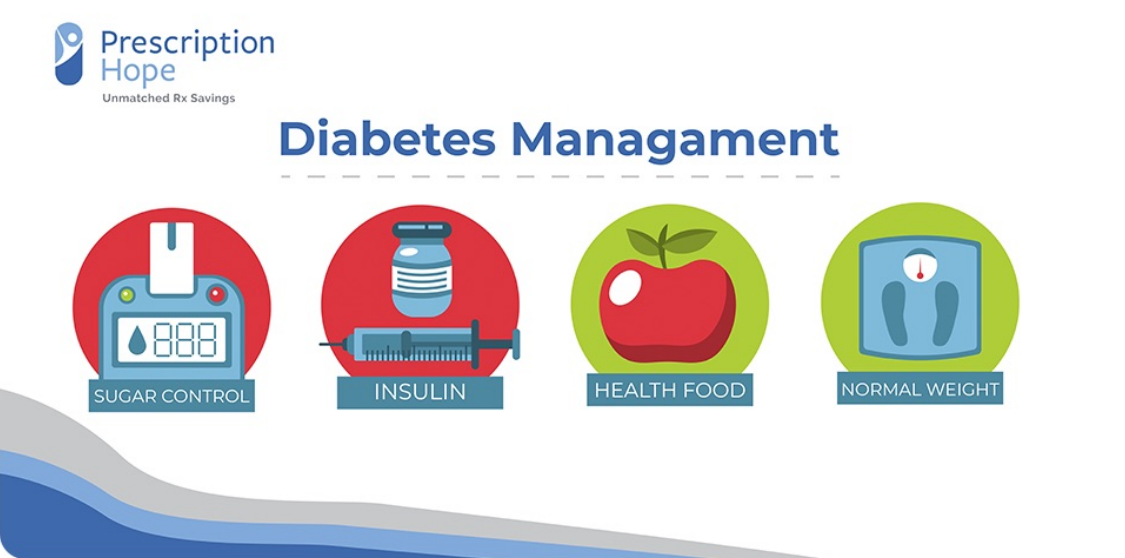What is Diabetes?
Posted by Prescription Hope - See Editorial Guidelines (Last Updated On: Mon Jul 24 2023)

About 1 in 10 people of all ages in the U.S. have diabetes, and a little over 7 million adults over the age of 18 are not even aware that they have the disease. It’s a fairly common health condition, but what exactly is diabetes? How do you know if you have it, and once you are diagnosed, how can you manage it?
This chronic disease affects the way the body converts glucose (sugar) into energy for the body to use right away or store for later when it’s needed. When glucose isn’t used properly, it remains in the bloodstream and causes high blood sugar levels, which can lead to a number of serious conditions, such as damage to nerves, the heart, or kidneys.
A normally functioning body naturally produces a hormone known as insulin, which is made by the pancreas. Insulin’s job is to take the sugar from the foods we eat and convert them into the energy needed for the body’s tissues and organs to do their jobs, and keep everything in the body working as it should be. If you have diabetes, the pancreas either doesn’t produce enough insulin, or the insulin that is being produced is not functioning properly.
This hormone, insulin, has not always been something that people understood, and that caused a lot of early deaths for people with diabetes because the medical world had not yet figured out how to manage the disease.
Believe it or not, last year was the 100th anniversary of the discovery of insulin. As insulin is clearly a necessity for survival, its discovery is incredibly important. You can imagine how many advancements in medicine have been made since then, and how people’s lives with diabetes have improved — but diabetes has not been cured, and new cases are popping up every year.

There are four kinds of diabetes: Type 1, Type 2, Prediabetes, and Gestational Diabetes. The most common is Type 2, which occurs in up to 95% of those who have diabetes, typically in adults and the elderly. People with Type 2 diabetes do not naturally produce enough insulin or they don’t respond normally to insulin. This happens because the body’s cells have become resistant to insulin for some reason, and glucose is not able to get into the cells, leaving it nowhere to go but stick around and build up in the bloodstream.
Prediabetes is a step below Type 2, when blood sugar levels are higher than they should be, but not as high as they are in individuals diagnosed with Type 2.
People with Type 1 diabetes don’t produce insulin at all because the cells that should be producing insulin in the pancreas have been destroyed. Type 1 diabetes is less common, affecting up to 10% of those with diabetes, usually children and young adults. To make up for the lack of insulin production in the pancreas, people with Type 1 diabetes have to physically take insulin everyday in order to live.
Gestational diabetes occurs because hormones made by the placenta during pregnancy increase the body’s cells’ resistance to insulin. There really are not any noticeable symptoms when you have Gestational diabetes, but all pregnant women’s OB-GYNs will test them for this condition at around 24-28 weeks by giving them a glucose test to test their levels.
There are certain symptoms to watch out for that could indicate you have Type 1 or 2 diabetes, and should be tested. These include feeling tired, weak, or extra thirsty; experiencing blurred vision, dry mouth, or numbness or tingling in the hands and feet; cuts or sores that take a long time to heal or infections that come out of nowhere; losing a noticeable amount of weight unintentionally; and urinating more than usual.
Some women will also have more frequent urinary tract infections or yeast infections, and some men may experience a decrease in their sex drive or muscle strength.

It you have Type 1 diabetes, symptoms will typically come on much more rapidly, and start to show during childhood or when you’re a teen or young adult. You may also experience additional symptoms like nausea and vomiting. If you have Type 2 diabetes or prediabetes, symptoms usually won’t show themselves until later on in life, and they could even take years to develop.
Regardless of whether you are diagnosed with Type 1 or 2 diabetes, prediabetes or gestational diabetes, it is a serious condition that requires a lot of attention and care in order to ensure it is managed and controlled correctly. If you have recently been diagnosed with diabetes, it can be a little scary as you learn new ways to take care of your health, but thankfully, there are a lot of resources available to help, including of course, your own healthcare provider.
One of the most important things to learn at the beginning of your diagnosis is what’s known as your diabetes ABCs: Al C Test, Blood Pressure, Cholesterol. The Al C test measures average blood sugar level over a period of three months. This is important to know because you need to know what your goal should be so you know if your levels are too high when you do your daily blood sugar checks. You also need to know your goal numbers for blood pressure and cholesterol for the same reasons: so you know if they become too high and could potentially cause harm.
If you have Type 1 diabetes, symptoms will typically come on much more rapidly, and start to show during childhood or when you’re a teen or young adult. You may also experience additional symptoms like nausea and vomiting. If you have Type 2 diabetes or prediabetes, symptoms usually won’t show themselves until later on in life, and they could even take years to develop.
Regardless of whether you are diagnosed with Type 1 or 2 diabetes, prediabetes or gestational diabetes, it is a serious condition that requires a lot of attention and care in order to ensure it is managed and controlled correctly. If you have recently been diagnosed with diabetes, it can be a little scary as you learn new ways to take care of your health, but thankfully, there are a lot of resources available to help, including of course, your own healthcare provider.
One of the most important things to learn at the beginning of your diagnosis is what’s known as your diabetes ABCs: Al C Test, Blood Pressure, Cholesterol. The Al C test measures average blood sugar level over a period of three months. This is important to know because you need to know what your goal should be so you know if your levels are too high when you do your daily blood sugar checks. You also need to know your goal numbers for blood pressure and cholesterol for the same reasons: so you know if they become too high and could potentially cause harm.
Treatment for diabetes varies depending on the type you have. For Type 1, the treatment is pretty firm: you need to take insulin every single day because your body doesn’t make it itself. For Type 2, certain medications and/or insulin may be prescribed, but there are also lifestyle changes that can help you manage your condition, such as losing weight, maintaining a more frequent exercise routine, and changing your eating habits to include more fresh fruits and vegetables, whole grains, and in general, food that is high in fiber and low in calories, fat, sugar and salt. You can find diabetes-specific cookbooks to help you with meal planning, or talk to a nutritionist if you find that it’s hard to stick to a plan and stay accountable on your own.
Additionally, it’s important to learn how to manage stress, since stress can raise blood sugar. Find activities that help keep you calm during times when you start to feel anxious. Engage in activities like meditation, breathwork or yoga, reading, gardening, listening or music, or anything else that brings you into a happier, more tranquil state of mind.
11 you have prediabetes, the goal is to stabilize the blood sugar so that it doesn’t increase enough for a Type 2 diagnosis, or better yet, decreases. Focus on making those same lifestyle changes that can help with Type 2 diabetes.
For gestational diabetes, treatment is typically just making lifestyle changes during your pregnancy. Medication and/or insulin will only be prescribed if the target glucose level can’t be met or is deemed to be too high.
It can be a little frustrating when you see the price tag on some of the necessary medications for diabetes, especially when combined with all the doctors visits and other medical expenses. This is why it’s helpful to use a service like Prescription Hope that provides customers with access to a list of over 1,500 FDA-approved, brand-name medications for a small service fee of $60.00/month per medication through our medication access service — and yes, insulin and other diabetes medications are included in that list. This can be a huge help, especially when the monthly retail cost for diabetes medications is usually hundreds of dollars.
Your health shouldn’t suffer because of high medication costs. Prescription Hope brings you affordable options no matter where you are in your diabetes treatment. Learn more about how Prescription Hope works and enroll to see if you pre-qualify for medical assistance.


